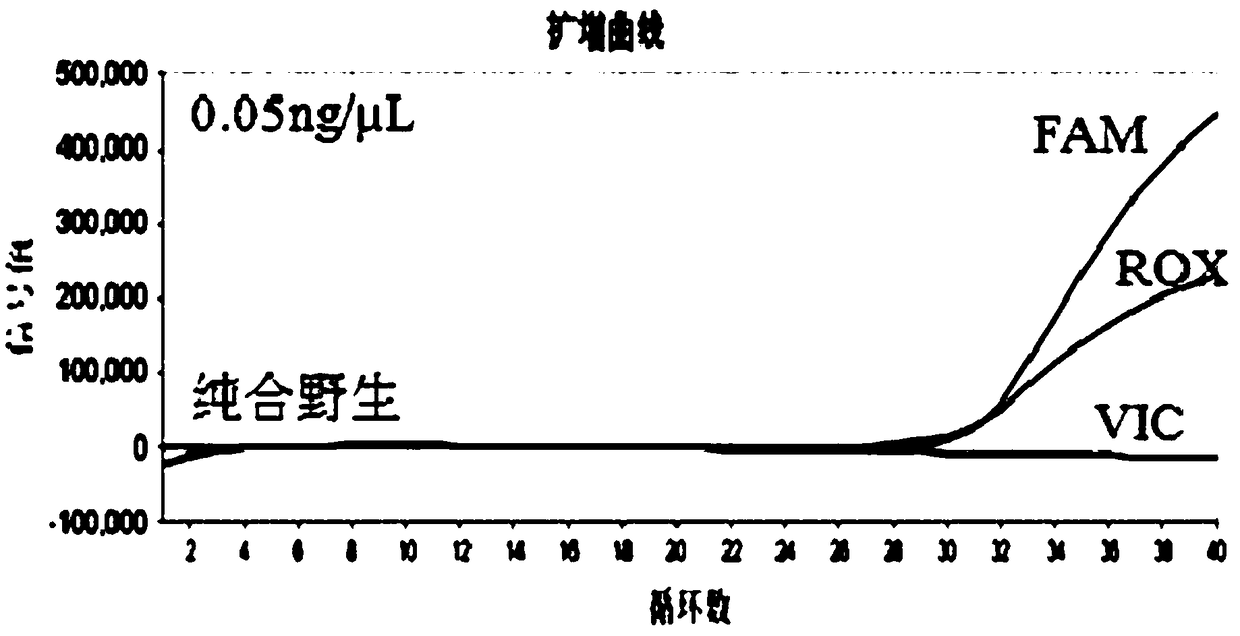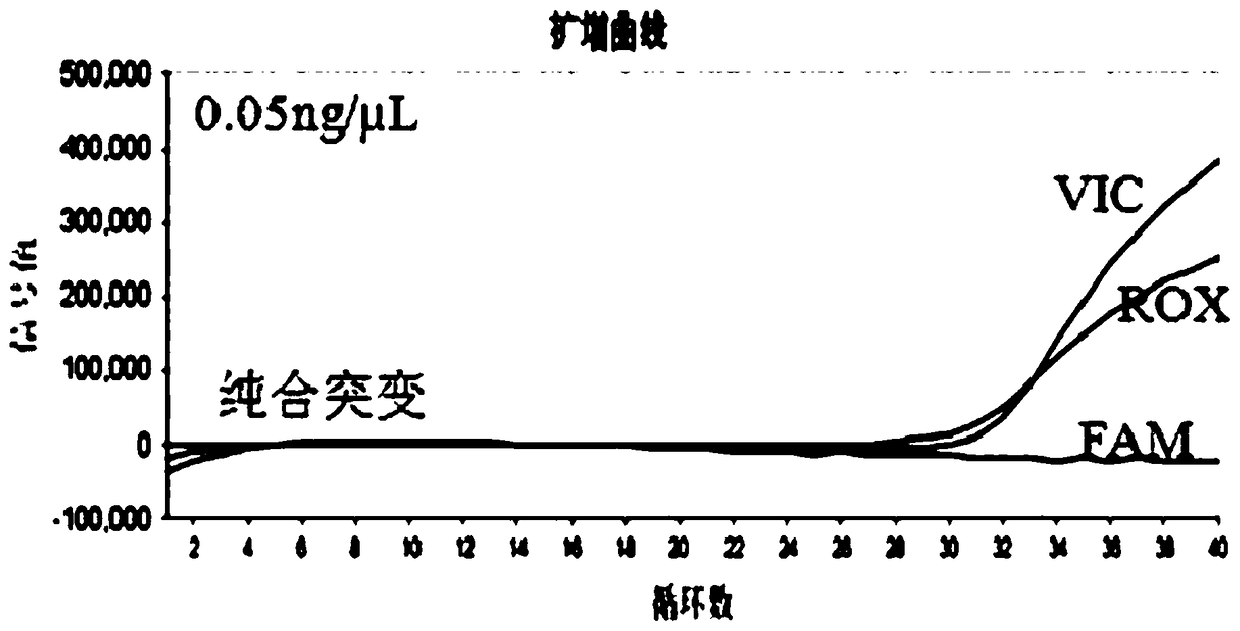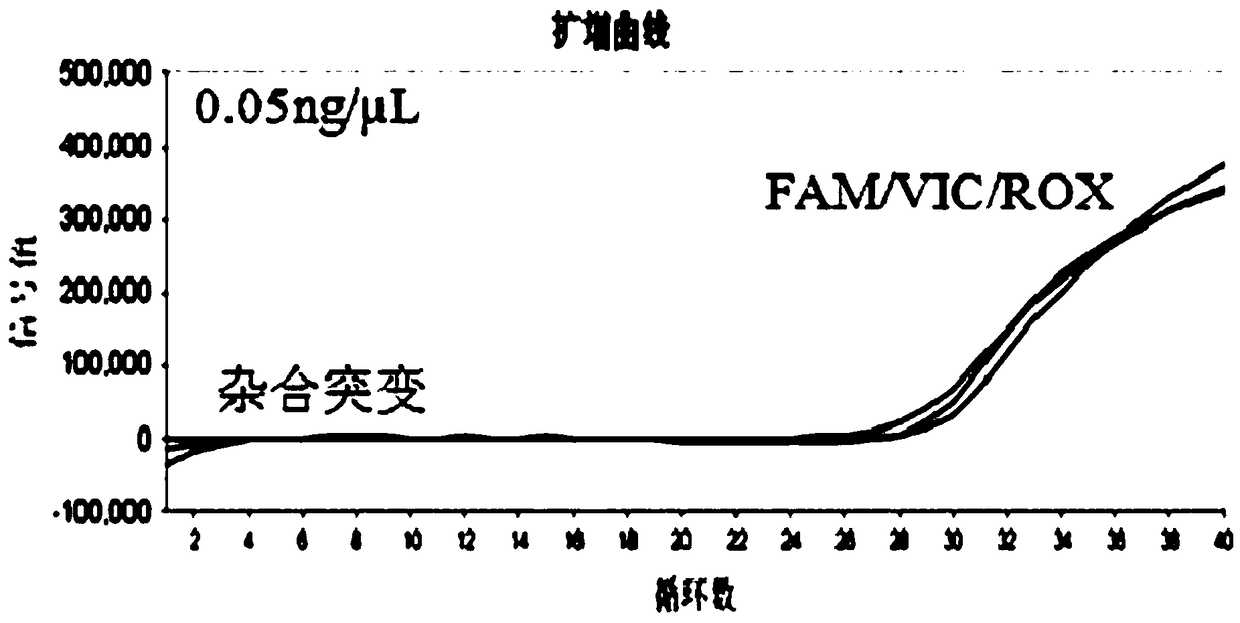Product for detecting polymorphism of CYP3A5 gene and detection method and application of product
A gene polymorphism and specificity technology, applied in the field of biomedicine, can solve the problems of detection sensitivity and specificity limitations, misoperation of reagents, increase of wrong detection, etc., to achieve true and reliable results, accurate and reliable results, and short time-consuming Effect
- Summary
- Abstract
- Description
- Claims
- Application Information
AI Technical Summary
Problems solved by technology
Method used
Image
Examples
Embodiment 1
[0146] Prepare the kit for detecting CYP3A5 gene polymorphism of the present invention, comprise the following steps:
[0147] A). Primer and probe screening
[0148] According to the CYP3A5 gene sequence published in the NCBI database, multiple sets of primer-probe combinations were designed, PCR systems were prepared respectively, the same wild-type and mutant templates were detected, and primer-probe combinations with better amplification sensitivity and specificity were selected.
[0149] B). Primer and probe synthesis:
[0150] The primer-probe combination screened was synthesized, specifically including: CYP3A5*3 site upstream and downstream primers SEQ ID NO: 1, SEQ ID NO: 2, specific probes SEQ ID NO: 3 and SEQ ID NO: 4. And label the FAM fluorescent group at the 5' end of SEQ ID NO:3, and mark the MGB-NFQ non-luminescence quenching group at the 3' end; at the same time, carry out LNA modification at the position containing the target allele in the middle of SEQ ID NO...
Embodiment 2
[0164] The sample to be tested was detected with the kit prepared in Example 1.
[0165] In this example, three cases of genomic DNA were collected, and the genotypes were homozygous wild, homozygous mutant, and heterozygous mutant.
[0166] 1. DNA sample dilution
[0167] Take 3 samples of genomic DNA and dilute to 0.05ng / μl.
[0168] 2. Fluorescent quantitative PCR detection of samples
[0169] Add 2 μl of the sample in step 1 to 23 μl of the CYP3A5*3 detection PCR system premix of the kit in Example 1, so that the total volume of the reaction system is 25 μl, and put it into a fluorescent quantitative PCR instrument, and set it as follows Amplification reaction after PCR reaction procedure:
[0170] 10min at 37°C;
[0171] 95°C for 5 minutes;
[0172] 95°C for 15s, 60°C for 60s, 40 cycles; collect the fluorescence signals of FAM, VIC and ROX after each cycle.
[0173] 3. Analysis of test results of samples:
[0174] CYP3A5*3 site A / A homozygous wild detection results...
Embodiment 3
[0182] The sample to be tested was detected with the kit prepared in Example 1.
[0183] In this example, two cases of genomic DNA were collected, and the genotypes were homozygous wild and homozygous mutations, respectively.
[0184] 1. DNA sample preparation
[0185] Two cases of genomic DNA samples were taken and quantified to 250ng / μl.
[0186] 2. Fluorescent quantitative PCR detection of samples
[0187] Add 2 μl of the sample in step 1 to 23 μl of the CYP3A5*3 detection reaction system of the kit in Example 1, so that the total volume of the reaction system is 25 μl, and put it into a fluorescent quantitative PCR instrument, and set up the PCR reaction as follows Amplification reaction after the program:
[0188] 10min at 37°C;
[0189] 95°C for 5 minutes;
[0190]95°C for 15s, 60°C for 60s, 40 cycles; collect the fluorescence signals of FAM, VIC and ROX after each cycle.
[0191] 3. Analysis of test results of samples:
[0192] CYP3A5*3 site A / A homozygous wild d...
PUM
| Property | Measurement | Unit |
|---|---|---|
| Sensitivity | aaaaa | aaaaa |
Abstract
Description
Claims
Application Information
 Login to View More
Login to View More - R&D
- Intellectual Property
- Life Sciences
- Materials
- Tech Scout
- Unparalleled Data Quality
- Higher Quality Content
- 60% Fewer Hallucinations
Browse by: Latest US Patents, China's latest patents, Technical Efficacy Thesaurus, Application Domain, Technology Topic, Popular Technical Reports.
© 2025 PatSnap. All rights reserved.Legal|Privacy policy|Modern Slavery Act Transparency Statement|Sitemap|About US| Contact US: help@patsnap.com



